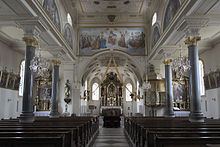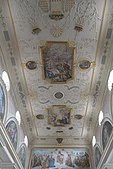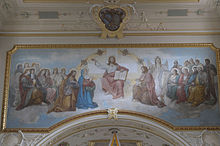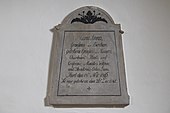St. Benedict (Odelzhausen)
The Catholic parish church of St. Benedikt in Odelzhausen , a municipality in the Upper Bavarian district of Dachau , goes back to a medieval church that was designed in the early Rococo style in the 18th century . The church, which is consecrated to St. Benedict of Nursia , the founder of the Benedictine order , is one of the protected architectural monuments in Bavaria.
history
A church in Odelzhausen is mentioned for the first time in a deed of donation from 814. In the Konradinische Matrikel , the list of goods of the Diocese of Freising compiled in 1315/16, the church of "Otolshausen" is listed as a branch church of the original parish Sulzemoos . Odelzhausen only became an independent parish in 1923, with the branches Miegersbach, Essenbach and Taxa .
The previous Gothic church was destroyed during the Thirty Years War and then rebuilt in the Baroque style. Around 1730 the nave was renewed and decorated and refurbished in the early Rococo style with stucco and frescoes .
Around 1890 the church was redesigned and expanded. The ceiling including plaster and paintings was raised by three meters and a new nave with side aisles was built underneath .
architecture
Exterior construction
The square substructure of the 46 meter high bell tower goes back to the medieval church building from the time before 1400, the octagonal tower and the spire come from the time the church was rebuilt around 1890. The upper part of the tower is pierced by eight oval openings. the lower part, divided by corner pilasters and surrounding cornices, has connected sound arcades on all four sides in the neo-Gothic style .
The choir , which has been preserved from the late Gothic period , is supported on the outside by double-stepped buttresses .
inner space
The interior has been designed as a three-aisled pillar basilica since the renovation in the 1890s . The nave is divided into five axes . The flat ceilings of the aisles are supported by massive columns with gilded capitals in the Corinthian style and profiled warrior cornices .
The slightly retracted, three-sided closed choir is covered with a barrel vault with stitch caps and, like the ceiling of the central nave, covered with fine bandwork , with shells, acanthus tendrils and fruit baskets from around 1735.
Murals
The large painting on the wall above the triumphal arch depicts Jesus enthroned on a cloud, surrounded by apostles, saints and martyrs. In his left hand he is holding an open book on which the letters Alpha and Omega can be read. On his right, Mary and Joseph kneel holding a white lily, on his left you can see John the Baptist, with the Archangel Michael standing behind .
The wall paintings on the lunettes under the transversely oval upper aisle windows of the central nave were added after the renovation in the 1890s. They are executed in the style of the Nazarenes and depict episodes from the childhood of Jesus. The scenes show the birth of Jesus, the dream of Joseph, the flight to Egypt , Jesus in the carpenter's workshop, the death of Joseph and the death of Mary .
Frescoes
The ceiling frescoes were made around 1735/36 by the Dachau painter Franz Mayr (1707–1752). The large choir fresco is dedicated to the patron saint of the church, St. Benedict of Nursia. The smaller pictures depict episodes from his life.
The two large ceiling frescoes in the nave represent the Annunciation and the Adoration of the Shepherds . The smaller medallions framed by stucco cartouches depict the marriage of Mary and Joseph , the Visitation , the presentation of Jesus in the temple and the twelve-year-old Jesus among the scribes .
Leaded glass window
In the arched windows of the choir, smaller lead glass panes are inserted, which probably date from around 1890/93. They represent the four Latin Fathers of the Church , in the north Saint Augustine and Saint Ambrose , in the south Pope Gregory the Great and Saint Jerome .
The Annunciation and the birth of Jesus, attributed to the workshop of the Dachau-based glass painter Syrius Eberle (1887–1967), are depicted on two other panes. The panes depicting the flight to Egypt and a Pietà in the nave probably also come from his workshop .
The evangelist symbols are depicted on two panes in the nave , the bull of the evangelist Luke and the lion of the evangelist Mark , the eagle of the evangelist John and the man of the evangelist Matthew .
Other panes in the nave from around 1890 depict a pelican nourishing its young with its blood, the Lamb of God on the book with seven seals and the flag of victory. The depictions of a chicken and an egg framed by a star are reminiscent of the founding legend of the Taxa monastery .
Furnishing
- The miraculous image in the middle of the high altar comes from the Maria Stern monastery in Taxa , an enthroned Mother of God with baby Jesus from 1618, with a colored version from the 20th century. The carved figures of St. Joachim and St. Anna are dated around 1500.
- The double pulpit made of green and yellow marbled wood probably also belonged to the inventory of the Taxa monastery, which was dissolved in 1803. Around 1900 it was given its current gold-plated carved decoration, under which inlays made of various woods and pewter from the second half of the 17th century were partially exposed.
- The pulpit cross on the north side of the nave was also taken over from the Taxa monastery. It is marked with the year 1767, but is dated earlier. At the foot of the crucifix is a Mater Dolorosa , who pierces a sword through the chest.
Epitaphs
- Grave slab for Christoph Aver von und zu Puelach
A grave slab made of Solnhofen limestone is attached to the south wall of the nave . It was made in 1602 for Christoph Aver von und zu Puelach and is decorated with a relief of a knight. He holds a rosary in his hand, at his feet lies the helmet of his armor as a sign of his death. Six coats of arms are carved on the edge and a Latin verse on top, the signature 'C. Mustard. f. ”to read.
- Several epitaphs are dedicated to the Counts of Minucci, the former lords of the court .
- Under the gallery, a coat of arms made of sandstone with a lion in its paws and a Solnhofen lime slab with an inscription remember the court judge Franz Alexander Faber, who died in 1730.
literature
- Georg Dehio: Handbook of the German art monuments. Bayern IV: Munich and Upper Bavaria . 2nd edition, Deutscher Kunstverlag, Munich 2002, ISBN 3-422-03010-7 , p. 931.
Web links
- Parish Church of St. Benedikt in Odelzhausen Churches and chapels in Dachauer Land (accessed on October 20, 2015)
Individual evidence
- ↑ List of monuments for Odelzhausen (PDF) at the Bavarian State Office for Monument Preservation, monument number D-1-74-135-1
Coordinates: 48 ° 18 ′ 41.1 ″ N , 11 ° 11 ′ 41.8 ″ E
















